H.G.Co. Petticoat Beehives
by H.G. "Bea" Hyve
Reprinted from "Crown Jewels of the Wire", February 1996, page 14
A Closer Look - Part 3
TYPE OF GLASS AND LOCATION OF MANUFACTURE
AS RELATED TO AGE
It is doubtful if any of the PETTICOAT beehives were made at Muncie. There
are very few of these made in the color of glass used at Muncie, and there are
no signs of Muncie presses or engraving. (For one possible exception, see data
under the "STRAIGHT-SIDES" heading later on in this article.)
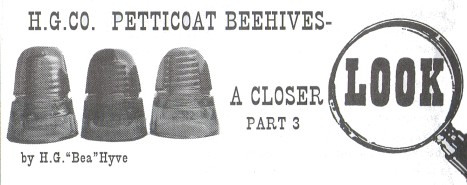
Another
point; in 1911 the CD 152 replaced the CD 145 as the standard for both Western
Union and Bell. All CD 152s except for the very latest (which have the
later-style embossing) have machined letters. Probably about 1895 production was
started at Muncie on the H. G. CO. CD 145 in Hemingray blue; and these were the
Western Union standard used for about 15 years, or until the CD 152 was adopted.
After that, Hemingray offered the CD 145 embossed "HEMINGRAY" with or
without drips.
There's no real proof, but it seems hard to believe that the H.
G. CO. PETTICOAT insulator continued to be made at Covington for a long period
of time simultaneously with the Muncie H. G. CO. that was standard to 1911 when
the CD 152 came in. The later Muncie production is of so much higher quality
that there would have been no real reason for maintaining production of both
(and it seems doubtful that any items so crude and colorful would have been in
production as late as that. More on quality and uniformity of color later on.)
Also, they were probably discontinued when Muncie tooled up to make trainloads
of those plain H. G. CO. pieces for Western Union, probably in the mid-1890s.
So, "our" beehives were probably primarily made during the ten-year
period from 1885 to 1895, give or take a year either way, making their years of
production about 12 years at the most. However, the molds were kept and were
used as required, perhaps sometimes after a period of nonuse.
QUALITY
Having touched on quality in the previous paragraph, it might be of interest
to give more details here. The quality and appearance of most of
"our" beehives is that of "older" glass. Many units contain
large bubbles, small rocks, bread-like impurities, and straw marks. In the early
years of glass manufacturing, these things were more common than they were
later on in glass-making history. The atmosphere in most of the plants was uncomfortable; the air was hot, and filled with smoke, dust, steam, toxic
gasses, and noise. Fires were common as were injuries to the workers. While even
today glass shops are not the most comfortable of places to work, Hemingray had
a reputation in its time for quality products. In the late 1800s, the making of
insulators certainly didn't demand the controls required of bottles, jars,
lamps, and so forth. But "our" beehives were good enough that the
purchasers were more than pleased. In spite of the times in which they were
made, these beehives are of excellent quality. As time went on and conditions
and methods improved, so did the quality of the glass.
Although glass
manufacturers usually strived for good-quality products, purchasers, especially
later on, would issue specifications and drawings with measurements for
insulators to glasshouses. And, over time, they would tighten up those specs.
Purchasers would also make inspections using gauges. Here's a quote from a spec
from Western Electric dated May 24, 1907: "The quality of the materials
used and the methods of manufacture, handling and shipment shall be such as to
ensure for the finished insulators the properties and finish called for in these
specifications. The manufacturer must make sure that all material and work is in
accordance with the specifications before the insulators are delivered. The
Western Electric Company is to have the right to make such inspections and tests
as it may desire of the materials and of the insulators at any stage of the manufacture,
such inspections not to include inspection of the
processes of manufacture. The inspector of the Western Electric Company shall
have the power to reject any material or insulator which fails to satisfy the requirements
of these specifications. Inspection shall not, however,
relieve the manufacturer from the obligation of furnishing satisfactory
material and sound, reliable work. Any unfaithful work or failure to satisfy the
requirements of these specifications that may be discovered by the telephone
company on or before the receipt of the finished insulators shall be corrected
immediately upon the requirement of the telephone company,
notwithstanding that it may have been overlooked by the inspector.
"Where maximum and minimum dimensions are shown the dimensions shall be within the limits specified. Where limits are not shown the dimensions shall be
approximate... All material and workmanship unless otherwise specified shall be
of the best grade... The insulators shall have a finish in accordance with
the best commercial practice ensuring, as far as possible, freedom from flaws,
cracks, blow holes, sharp edges and other defects. C. E. Scribner, Chief
Engineer." (These specs were for, standard, pony, and transposition
insulators.)
According to additional information in these specs, size was to
be uniform within each design. There were visual inspections made as well as
actual measurements taken. The threads were checked with a full-sized threaded
steel pin (see Figure 22), and they were to be only so far from the crown of the
insulator, taking at least two complete revolutions to release the insulator
from the gauge, be smooth and of uniform pitch, well-centered within the
insulator, and the gauge could not touch the inner surface of the petticoat.
Every insulator was not checked; ten out of 100, 15 out of 1 ,000, etc. Of the
amount checked, very few could be defective if the whole group was to be
accepted.
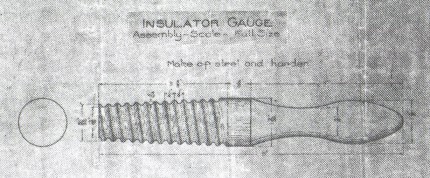
Figure 22
Engineering drawing of steel insulator gauge
from Western Electric
December
12, 1904
(Courtesy of Glenn Drummond)
Although these Particular specs applied to insulators made a bit later than "ours", I felt that this
information would be of interest to students of insulator history.
"PETTICOAT"
The word "PETTICOAT" is embossed on the back of the skirt on
"our'" beehives. (See Figure 23 ) As stated earlier, the petticoat
idea was patented by Oakman in 1883. Brookfield, Hemingray's competitor, was
the only one to mark their insulators with Oakman's patent date, but then
Brookfield embossed a lot of information on their insulators. Possibly for this
reason, Robert Hemingray purposely stayed away from embossing his insulators in
the same manner. Additionally, Brookfield had made arrangements with Oakman for patent
rights, so that probably wouldn't have been possible for Hemingray.
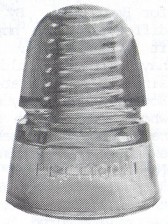
Figure 23
Back "PETTICOAT" embossing
(Courtesy of Roger Inselman)
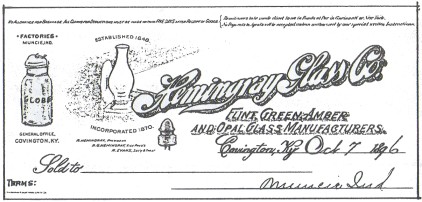
Figure 24
Company invoice-head (restored by author)
October 7, 1896
(Courtesy of N. R.
Woodward)
By styling the
insulator somewhat differently, he hoped to avoid a lawsuit, which it seems he
did. And as already stated, he may have felt he could not be violating any
patents since his insulators had no paraffin recess. However, Hemingray did ask
the advice of a lawyer, whose answers are found in a letter from Cincinnati
dated December 7, 1888: "I have carefully examined the patents on
insulators No. 288,360 [double petticoat]... and No. 14674 ["beehive"
design]... Upon comparing this [first] claim with the insulator submitted to me
and proposed to be manufactured by you, I find this insulator has no [paraffin
recess], which is a prominent and essential element of the claim, and it does
not infringe this claim... The only elements of this [second] claim, that are at
all new, are the shield E [the space between the outer skirt and the petticoat] and the
recess H [threaded pinhole]... in manufacturing the insulators, you would not
infringe the claim...The novel elements of the claim, [namely]: The shield E,
and recess H, are clearly shown in the old insulator manufactured by you... the
only difference being a difference of degree, which is never patentable... I
can therefore unhesitatingly say, that this claim is invalid upon the evidence
now in your possession. I believe other evidence can be produced also, to defeat
the claim...As to the design patent.. . The last form of insulator submitted to
me, is not a paraboloid, the lower part or skirt flares outwardly, making a
reverse curve. It would not therefore infringe the claim of the design patent,
but in addition...it is within my own knowledge and doubtless within your
[sic], that insulators in the shape of a paraboloid, were made and used long
prior to 1884, and while they may not be shown in the records of the Patent
Office, they are certainly very old in public use, and the patent is
unquestionably invalid." Was this request made by Hemingray because of a
threat of litigation, or was he seeking advice just in case. We may never know.
The word "petticoat" didn't "belong" to either Oakman or
Brookfield. It appears to be a Hemingray invention, having been referred to in
others' papers as an "annular recess", which is actually the space
between the outer skirt and the petticoat. There's no reason to believe that
there was ever any conflict over the use of that word. (Had a conflict arisen
over the Oakman patent, it would have concerned the styling of the insulator
rather than what it was called.) We may never know for certain if the use of the
word "petticoat" was tied to agreements with Oakman, since most of
Hemingray' s records (from Covington also) were destroyed in the 1892 fire at
the new Muncie factory. In fact, because of that and other events, many
questions concerning the operation of the company and its products may never be satisfactorily answered.
THREE STYLE VARIATIONS
H. G. CO. PETTICOAT beehives have been found so far in three major style
variations; the "tall-dome" style, "straight-sides" (or
"Postal" style), and "normal" style. (See Figure 25) Both
the tall-domes and normals are classified as "flared-skirt" styles. The
color variety and general (older) appearance of the glass in the flared-
skirts is almost positive proof that they were produced at Covington. It is
extremely doubtful if any were made at Muncie, as stated earlier. (More on this
later.)
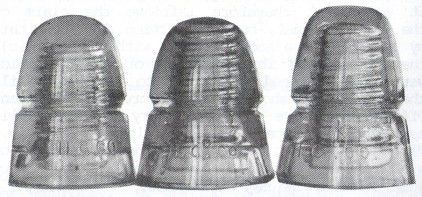
Figure 25
Three style variations
Left to right: Straight-sides, normal, and tall-dome
styles
(Courtesy of Chris Hedges)
"TALL-DOME" STYLE
The tall-dome style beehives show up once in a while, though not nearly as
often as the normal style. 'They are found mostly in light green with a little
snow, although a few have been seen in green aqua, three are known in jade milk
with pronounced milky swirls, and recently one came to light in blue aqua, full
of snow, with a large bubble and a small olive swirl in front. All have relatively flat crowns compared to the others, and every one
I've had so far came from the same mold (with a hand-engraved "K" in
front), so apparently there was only one mold like that. How did the difference
happen? Perhaps the mold maker deviated slightly from the basic height and
realizing his mistake, flattened the crown somewhat. Although the skirts are the
same vertical size as the normal-skirt style, even with the flattened crown this
style is still noticeably taller from wire groove to crown than the normal
style. 'This was most probably an unintentional variation rather than an
engineering specification.
"STRAIGHT-SIDES" STYLE
The straight-sides are Postal-style beehives. They are of later manufacture
than the others, yet seem to be Covington glass. There are questions, however,
concerning their age and place of manufacture. A few of these have surfaced, but
they are not nearly as common as the other styles. Because of the improved
quality of glass and newer, sleeker design, it is possible that they are a
Muncie product. However, they could also be from Muncie molds used at Covington,
because of the unusual colors in which they have been found. So far, they have
turned up in three or four shades of royal purple, green aqua, and pale green.
Along with the different-looking colors, the letters appear to be machined
instead of hand-engraved.
The royal purples mayor may not have been sun-colored,
but may have been manufactured that color at a later date at Muncie, possibly
from cullet from old purple bottles. Another possibility is that the color came
from glass from a tank being used to make other glassware of that color. The
diameter of the more slender straight-sides beehive (at the base) measures 1/4" less than the flared-skirt variety. The glass is "cleaner", with
few bubbles, snow, straw marks, or impurities sometimes found in the flared-skirts. Also, no straight-sides has yet been seen with skirt or crown
letters.
Were new molds perhaps made up at Muncie so that Hemingray could run
these as replacement insulators? It was an extremely popular style, and as the
lines where the first ones were serving needed replacements, Hemingray could
have been asked to make more after they had been at Muncie for many years. It
is doubtful if they were intended for the Canadian market. No Postal CD 145 was
used in Canada or manufactured by a Canadian firm. And although they are similar
to a CD 143, when Canada did finally go to a double petticoat style, they went
to the big ones like G. N. W. TEL., etc. Of course, at this point it is a
guessing game concerning when, where, and. why they were made, and we will
probably never know the true story.
EMBOSSING DETAlLS
There are basically two forms of embossing on these beehives; hand-engraved
and machined. ( See Figure 26) The hand-engraved letters are larger and
more crudely formed, whereas the machined letters are smaller and more perfect. Although, generally speaking, the beehives with the
hand-engraved letters are probably older, it could be possible that the more
perfect letters are older. They did have the means of making perfect letters in
glass early on. Just as a concept to evaluate: Suppose at first the mold
engravers took time for precise letters. Then, as demand increased dramatically
and more presses were put into service, they were told, to heck with neat
letters, just get the molds out of the shop and onto the presses. So the letters
were scrawled in as fast as possible. That is only a notion, but possible.
Remember, the most crude and imperfect Brookfield insulators were made during
their last months of operation when everything started to fall to pieces.
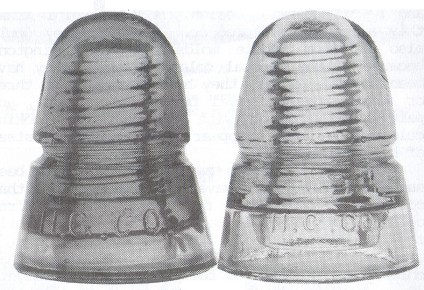
Figure 26
Two more examples of hand-engraved and machined letters
(See also Figure
21)
(Courtesy of Ray Klingensmith)
SKIRT AND CROWN LETTERS
The flared-skirt series (normal and tall-dome styles) are often found with
skirt and crown letters. (See Figures 27 and 28 respectively) (To call them
"petticoat" letters is a misnomer, as they actually appear on the
skirt, even though that is considered the outer petticoat on a double petticoat
insulator.) Of those found so far, these letters go from "A" through
"N", with the possible' exception of "F". (More on "F" later.) No
numbers have yet been found. Sometimes the letter appears on the front of the
skirt, sometimes on the back (see Figure 29), and at times, letters are found
on both skirt and crown. Then again, some pieces have no letters at all. So
far, those found have displayed a pattern; only certain letters appear above
the H. G. CO. embossing, while certain others only appear below. (See Figures 27
and 30) Also, where both back and crown letters exist on the same unit, they
are always the same letter. (Front and crown letters on the same beehive are
extremely rare: I've only heard of two.)
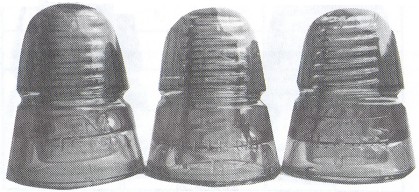
Figure 27
Skirt letters
Left to right: Front (top) "M", back (bottom) "H", front
(bottom)
"J"
(Courtesy of Roger Inselman)
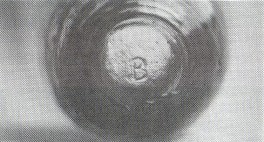
Figure 28
Crown letter "B"
(Courtesy of Roger Inselman)
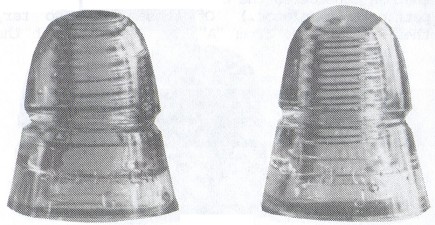
Figure 29
Skirt letters
Back (bottom) "G" and front (bottom) "J"
(Courtesy of Chris Hedges)
The accompanying chart (Figure 31) will make it easier to see the pattern,
also showing that the letters used are consecutive (not random through the
alphabet).

Figure 30
Showing which letters appear on skirt front and back
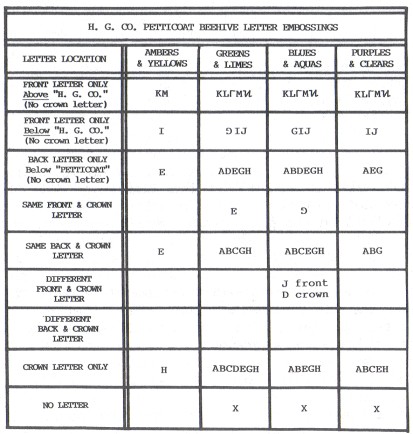
Large Image (152 Kb)
Figure 31
These letters served primarily as shop letters. Usually a team of four men
formed a shop in a glassmaking establishment, and each had his own job in the completion
of the steps necessary to produce a glass item. Shop letters (or
numbers) served as a means of determining the output of one shop as the product
emerged from the annealing lehr (slow-cooling oven). Visualize the petticoat
insulators being made simultaneously on several hand presses, each with a single
mold. From the press, the insulators were placed immediately into the huge
lehr. Twenty-four to 36 hours later when they came out at room temperature ready
for the packing process, they were sorted by the shop letters and counted (or
perhaps weighed after packing), in order to deternine pay for the press operator
and his helpers.
It is not likely that these letters were just mold letters,
used to spot problems with a certain, mold (by looking at the letter involved).
The above application is more logical. However, they might have served somewhat
as mold identification, since the letter certainly would pinpoint the source if
the defects in the insulator were noted at the end of the lehr. But, in later
insulators made on semi-automatic presses with multiple molds (as the Hemingray
No. 40), the shop numbers are not mold numbers, since each mold on the press would
have the same number.
There is probably no real reason why the letters were put
in a certain spot. It would be up to the whim of the engraver or the wishes of
the persons who had to read them when they came out of the lehr. Where the
letter appears in two places (skirt and crown), evidently it was originally
engraved in one place (skirt), and then someone thought it would be easier to
read in the other place (crown). Naturally the same letter would appear in both
spots. Since the letters do not always look the same, this shows that they were
no doubt put on at different times by different engravers. As for the total
number of letters used, that would indicate how many molds there were. The mold
shop foreman would have kept track of those for his own purposes.
Shop letters are often
backward in the glass, meaning that they were engraved in the mold in the normal
position. It was probably easier that way, and since the purpose of the markings
was as it was, it would make no difference. An example is the letter
"N", which is always backward. (See Figure 21, left) It is one letter
that is easily confusing. Some shop letters are hardly identifiable as anything.
But those incomplete or unclear markings served their purpose just as well.
As for the upside-down "L", could it have been meant as an
"F"? On some units with stronger embossing, one can see the center bar
of the "F", but it is very faint and somewhat wavy as though it had
been scratched in the mold but not finished properly. (But if it is an
"F", why wasn't it embossed in back? You can see in Figure 30 that
there's no "F" in the sequence of letters embossed on the back. I tend
to believe that no "F" was used deliberately, to avoid confusion with
the "E".)
Since the publication of my article in 1979, new information has surfaced
about a certain letter. What was once thought to be a backward "C" has
been identified as an upside-down "G". (I saw that beehive myself.) So
this discovery tends to throw off any previous pattern that seemed to emerge,
making eight letters that appear on the front, and seven on the back. (However,
if the upside-down "L" is an "F", and the upside-down
"G" is a mistake, that would make only seven each.) As for front
letters, five appear above the "H. G. CO." embossing, and four below.
(All letters on the back appear below the "PETTICOAT" embossing.) As
for colors, of those beehives with letters, certain colors seem to have certain
letters. Just the ambers always have letters, whereas the straight-sides (in any
color) never have letters. All other colors are found both ways.
More in Part 4 next month...
|
